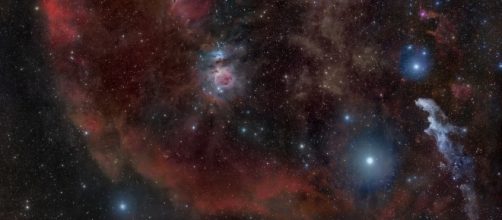Scientists using the gigantic radio telescope at the Arecibo Observatory in Puerto Rico have reported that they picked up strange signals from a nearby star in May. Meanwhile, a different team of scientists at the Instituto de Astrofiscia de Canarias in the Canary islands has discovered one of the brightest galaxies ever, the Cosmic Eyebrow.
Strange signals from Ross 128
On May 12 a team of scientists picked up what they described as “strange signals” that seem to be coming from the direction of a small, dim star named Ross 128. This itself is interesting since this red dwarf star about 11 light-years from Earth is not yet known to have any planets orbiting it. Plus, the star is around 2,800 times dimmer than our Sun.
Ross 128 was observed for 10 minutes with the radio telescope, with the signal being picked up during observation and being almost period throughout that time.
The Search For Extraterrestrial Life (SETI) groups have been made aware of the strange signals. The possibility of intelligent life being the cause of the signal is low, but it cannot be ruled out. Abel Mendez, an astrobiologist at the University of Puerto Rico, originally said he thought the signal was from a human satellite that passed through the telescope's line of sight and was using the same frequency.
However, he now says that “we have never seen satellite emit bursts like that.” A solar flare could also be the cause, as they can send out powerful radio signals.
On July 16, the Arecibo Observatory started the process of looking at Ross 128 and its surroundings to see if they can find the signal again.
The Cosmic Eyebrow is very bright
A newly discovered galaxy, which has been named the Cosmic Eyebrow, is one of the brightest galaxies that humans have ever discovered. It is about 1,000 times brighter than the Milky Way, has an extremely high rate of star formation and is 10 million light years away from Earth. The team behind the discovery has published their findings in the scientific journal, 'Astrophysical Journal Letters.'
https://t.co/CvDTwQFaVT shows the ATA observing Ross128, in the Virgo constellation, then Barnard's Star at 01:45UTC #ATASETI pic.twitter.com/zAUoiqzcw5
— Jon Richards (@jrseti) July 16, 2017
Researchers discover one of the brightest galaxies ever seen https://t.co/EmgpCgL2Q3 pic.twitter.com/l5aA48XF0U
— Engadget (@engadget) July 17, 2017
The discovery was made by using the gravitational lensing effect, which takes large objects in space and warps and enhances the light of smaller objects near them.
This caused the Cosmic Eyebrow to look 11 times bigger than it actually is, with it appearing as several different images. Scientists will now be able to study and analyze more information about the composition of the galaxy in the future by using these images.


